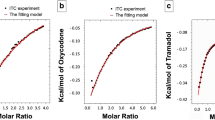Abstract
Purpose. The ion-pair partition of quaternary ammonium (QA) pharmacons with organic counter ions of different lipophilicity, size, shape and flexibility was studied to elucidate relationships between ion-pair formation and chemical structure.
Methods. The apparent partition coefficient (P′) of 4 QAs was measured in octanol/pH 7.4 phosphate buffer system by the shake-flask method as a function of molar excess of ten counter ions (Y), namely: mesylate (MES), acetate (AC), pyruvate (PYRU), nicotinate (NIC), hydrogenfumarate (HFUM), hydrogenmaleate (HMAL), p-toluenesulfonate (PTS), caproate (CPR), deoxycholate (DOC) and prostaglandin E1 anion (PGE1).
Results. Based on 118 of highly precise logP′ values (SD< 0.05), the intrinsic lipophilicity (without external counter ions) and the ion-pair partition of QAs (with different counter ions) were characterized. Linear correlation was found between the logP′ of ion-pairs and the size of the counter ions described by the solvent accessible surface area (SASA). The lipophilicity increasing effect of the counter ions were quantified and the following order was established: DOC ~ PGE1≫ CPR ~ PTS ≫ NIC ~ HMAL ≫ PYRU ~ AC ~ MES ~ HFUM. Analyzing the lipophilicity/molar ratio (QA:Y) profile, the differences in the ion-pair formation were shown and attributed to the differences in the flexibility/rigidity and size both of QA and Y.
Conclusions. Since the largest (in average, 300 ×) lipophilicity enhancement was found by the influence of DOC and PGE1 and considerable (on average 40×) increase was observed by CPR and PTS, it was concluded that bile acids and prostaglandin anions may play a significant role in the ion-pair transport of quaternary ammonium drugs and caproic acid and p-toluenesulfonic acid may be useful salt forming agents to improve the pharmacokinetics of hydrophilic drugs.
Similar content being viewed by others
REFERENCES
J. C. Dearden. Molecular structure and drug transport. In: C. Hansch, P. G. Sammes, and J. B. Taylor (Eds.): Comprehensive Medicinal Chemistry I–VI. Pergamon Press, New York, 1990. p. 241.
G. M. Irwin, H. B. Kostenbauder, L. W. Dittert, R. Staples, A. Misher, and J. V. Swintosky. Enhancement of gastrointestinal absorption of a quaternary ammonium compound by trichloroacetate. J. Pharm. Sci. 58:313–315 (1969).
K. S. Murthy and G. Zografi. Oil-water partitioning of chlorpromazine and other phenothiazine derivatives using dodecane and n-octanol. J. Pharm. Sci. 59:1281–1285 (1970).
C. K. Shim, R. Nishigaki, T. Iga, and M. Hanano. Determination of extraction constant, true partition coefficient and formation constant of ion-pair complexes of quaternary ammonium salts, tetrabutylammonium bromide and isopropamide iodide, with some organic anions by a solvent extraction technique. Int. J. Pharm. 8:143–151 (1981).
P. G. Green, J. Hadgraft, and G. Ridout. Enhanced in vitro skin permeation of cationic drugs. Pharm. Res. 6:628–632 (1989).
A. Adjei, S. Rao, J. Garren, G. Menon, and M. Vadnere. Effect of ion-pairing on 1-octanol-water partitioning of peptide drugs. 1: The nanopeptide leuprolide acetate. Int. J. Pharm. 90:141–149 (1993).
T. S. Gaginella, P. Bass, J. H. Perrin, and J. J. Vallner. Effect of bile salts on partitioning behaviour and GI absorption of a quaternary ammonium compound isopropamide iodide. J Pharm. Sci. 62:1121–1125 (1973).
J. H. G. Jonkman and C. A. Hunt. Ion pair absorption of ionizable drugs-fact or fiction? Pharm. Weekbl. [Sci]. 5:41–48 (1982).
R. P. Austin, A. M. Davis, and C. N. Manners. Partitioning of ionizing molecules between aqueous buffers and phospholipid vesicles. J. Pharm. Sci. 84:1180–1183 (1995).
D. Quintanar-Guerrero, E. Allemann, H. Fessi, and E. Doelker. Application of the ion-pair concept to hydrophilic substances with special emphasis on peptides. Pharm. Res. 14:119–127 (1997).
J. D. Meyer and M. C. Manning. Hydrophobic ion-pairing: altering the solubility properties of biomolecules. Pharm. Res. 15:188–193 (1998).
K. Trimble, J. Wan, and B. Floy. Effects of ion pairing agents on partition coefficient, tissue uptake and membrane permeability of LHRH analogues. Pharm. Res. 10:S–178 (1993).
R. Neubert, W. Böhm, S. Dabow, and W. Fürts. Arzneimittelpermeation, 17. Mitteilung:Zum Mechanizmus der Ionenpaarpermeation. Pharmazie 39:401–403(1984).
R. Neubert. Ion-pair transport across membranes. Pharm. Res. 6:743–747 (1989).
R. Neubert and W. Fürst. In vitro-Untersuchungen des Arzneistofftransportes. Pharmazie in unserer Zeit. 112–122 (1989).
R. Neubert and S. Fischer. Influence of lipophilic counter ions on the transport of ionizable hydrophilic drugs. J. Pharm. Pharmacol. 43:204–206 (1991).
R. Neubert, V. Schmalfuss, W. Wohlrab, and C. Huschka. Wirkstoff-penetration in die Haut und deren Modulation. Pharmazie in unserer Zeit. 11–22 (1996).
J. C. Dearden and G. M. Bresnen. The measurements of partition coefficients. Quant. Struct.-Act. Relat. 7:133–144 (1988).
K. Takács-Novák. Practical aspects of partition measurements according to GLP rules. Acta Pharm. Hung. 67:179–191 (1997).
R. M. Diamond. The aqueous solution behaviour of large univalent ions. A new type of ion-pairing. J. Phys. Chem. 67:2513–2517 (1963).
C. T. Jafvert, J. C. Westall, E. Grieder, and R. P. Schwarzenbach. Distribution of hydrophobic ionogenic organic compounds between octanol and water: Organic acids. Environ. Sci. Technol. 24:1795–1803 (1990).
F. Mohamadi, N. G. J. Richards, W. C. Guiga, R. Liskamp, M. Lipton, C. Caufield, G. Chang, T. Hendrickson, and W. C. Still. MacroModel—Molecular Mechanics. J. Comput. Chem. 11:440–467 (1990).
M. Akamatsu, T. Katayama, D. Kishimoto, Y. Kurokawa, H. Shibata. T. Ueno, and T. Fujita. Quantitative analysis of the structure-hydrophobicity relationship for N-acetyl di-and tripeptide amides. J. Pharm. Sci. 83:1026–1033 (1994).
Author information
Authors and Affiliations
Rights and permissions
About this article
Cite this article
Takács-Novák, K., Szász, G. Ion-Pair Partition of Quaternary Ammonium Drugs: The Influence of Counter Ions of Different Lipophilicity, Size, and Flexibility. Pharm Res 16, 1633–1638 (1999). https://doi.org/10.1023/A:1018977225919
Issue Date:
DOI: https://doi.org/10.1023/A:1018977225919




